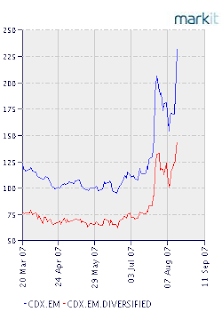For some reason the market doesn’t seem to want to admit that the housing market is on a continually downward trajectory and this will continue to impact the broader economy.
I guess it is hard to admit that things got way out of hand and now the economy and those benefiting from the ride will have to suffer a bit.
So on a day when the Dow was down over 275 pts, it seems appropriate to reflect on individuals who have been proactive about finding investment opportunities – on the short side – ahead of and during the current unwinding.
I stumbled upon an interview with Mark Cuban where he discussed a number of topics, including how “the internet is dead”.
But what jumped out at me was the criticism surrounding www.shareslueth.com described as:
A site Cuban “launched [in July 2006] with veteran business journalist Christopher Carey, with the stated goal of uncovering waste, fraud, and abuse in publicly traded companies”
Apparently the goal of the company is to uncover publicly traded companies who have misled or otherwise defrauded shareholders, while Cuban and others short these stocks in the mean time.
Some other heavy hitters in the finance industry were recently called out on Bloomberg.com and accused of hiring a “hit man” to investigate improprieties in a stock that they were shorting: Hedge Fund Hit Man Hired by Cohen, Loeb, Sender, Says Insurer
Both Cuban and these hedge fund investors have been accused of proactively seeking to profit from uncovering wrong doing – a type of event-driven arbitrage, where the investor in these cases create the event.
It is unclear exactly what the facts are surrounding these situations; however, even assuming the accusations are true (for what its worth I am skeptical of the Bloomberg piece in particular) the question remains:
Is proactive investigation of impropriety a bad thing?
It seems to me that having highly intelligent and sophisticated investigators out there searching for companies who have been guilty of fraud or otherwise manipulating their financial statements to the detriment of their shareholders is a good thing. Not only are potential perpetrators caught and exposed, but just as CEO’s are inventivized to be more honest through the deterrent example of Skilling, so too potential manipulators might think twice next time after seeing these other companies caught in their lies.
And if on a day like today, when the market gets hammered, these guys are strategically positioned because of this hard work – more power too them. That, in my mind, is really alpha.
